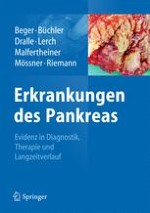Zusammenfassung
Abdominelle Schmerzen meist besonders starker Ausprägung, Maldigestion infolge der exokrinen Pankreasinsuffizienz und Diabetes mellitus sind die klinischen Leitsymptome der chronischen Pankreatitis unabhängig von ihrer Ätiologie und treten gemeinsam häufig erst im Spätstadium der Erkrankung auf. Schmerzen stellen meist das für die Patienten führende klinische Symptom dar und sind auch der häufigste Grund für eine interventionelle oder chirurgische Therapie. Auch wenn rekurrierende Schmerzen das Leitsymptom der chronischen Pankreatitis sind, muss bei Auftreten von Schmerzen differentialdiagnostisch immer auch an andere mögliche Schmerzursachen gedacht werden. Das klinische Bild möglicher Komplikationen der chronischen Pankreatitis ist vielfältig und umfasst u. a. neben Pseudozysten, Magenausgangs- oder Duodenalstenosen, entzündlichen Gallengangsstenosen auch Milzvenenthrombosen mit daraus resultierenden Komplikationen, Pseudoaneurysmen und pankreatogene Ergüsse.











